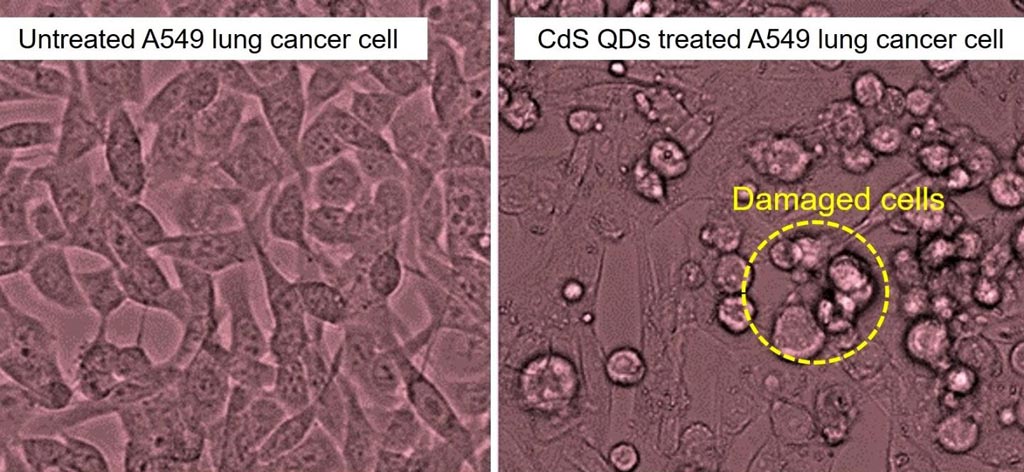Nontoxic QD Nanoparticles Inhibit Cancer Cell Growth
By LabMedica International staff writers
Posted on 30 May 2018
An environmentally friendly method has been developed for the production of quantum dot nanoparticles, which have antimicrobial properties and demonstrate potential for cancer diagnosis and treatment.Posted on 30 May 2018
Low-dimensional (<10 nanometer) semiconductor quantum dots (QDs) have received great attention for potential use in biomedical applications (diagnosis and therapy) for which larger nanoparticles (>10 nanometers) are not suitable. However, the chemical synthesis of quantum dots is complicated, expensive, and has toxic side effects.

Image: Photomicrographs of A549 lung cancer cells; left = untreated; right = treated with quantum dots (Photo courtesy of Swansea University).
To avoid these toxic effects, investigators at Swansea University (United Kingdom) developed a non-toxic plant-based alternative method of producing quantum dots, using tealeaf extract. Extracts derived from tealeaves (Camellia sinensis) contain a wide variety of compounds, including polyphenols, amino acids, vitamins, and antioxidants. The investigators added tealeaf extract to a mixture of cadmium sulfate (CdSO4) and sodium sulfide (Na2S) and allowed the solution to incubate until quantum dots formed.
The investigators examined the biological activity of these CdS QDs in different applications, namely, (a) antibacterial activity, (b) bioimaging, and (c) apoptosis of lung cancer cells. The antibacterial activity of the CdS QDs was evaluated and showed that CdS QDs effectively inhibited bacterial growth.
The investigators further reported in the March 9, 2018, online edition of the journal Applied Nano Materials that the quantum dots exhibited cytotoxicity toward A549 lung cancer cells when compared to a control (no QD treatment). The cytotoxic effect on A549 cancer cells was comparable to that of a standard drug, cisplatin. Furthermore, these CdS QDs produced high-contrast fluorescence images of A549 cancer cells indicating a strong interaction with the cancer cell.
To further understand the role of CdS QDs in bioimaging and the cytotoxic effect in A549 cells, the investigators performed fluorescence emission and flow cytometry analyses. The flow cytometry analysis confirmed that the CdS QDs were arresting A549 cell growth at the S phase of the cell cycle, inhibiting further growth of these lung cancer cells.
Senior author Dr. Sudhagar Pitchaimuthu, senior research fellow in engineering at Swansea University, said, "Our research confirmed previous evidence that tea leaf extract can be a non-toxic alternative to making quantum dots using chemicals. The real surprise, however, was that the dots actively inhibited the growth of the lung cancer cells. We had not been expecting this. The CdS quantum dots derived from tealeaf extract showed exceptional fluorescence emission in cancer cell bioimaging compared to conventional CdS nanoparticles. Quantum dots are therefore a very promising avenue to explore for developing new cancer treatments. Building on this exciting discovery, the next step is to scale up our operation, hopefully with the help of other collaborators. We want to investigate the role of tealeaf extract in cancer cell imaging, and the interface between quantum dots and the cancer cell. We would like to set up a "quantum dot factory" which will allow us to explore more fully the ways in which they can be used."
Related Links:
Swansea University








 (3) (1).png)





